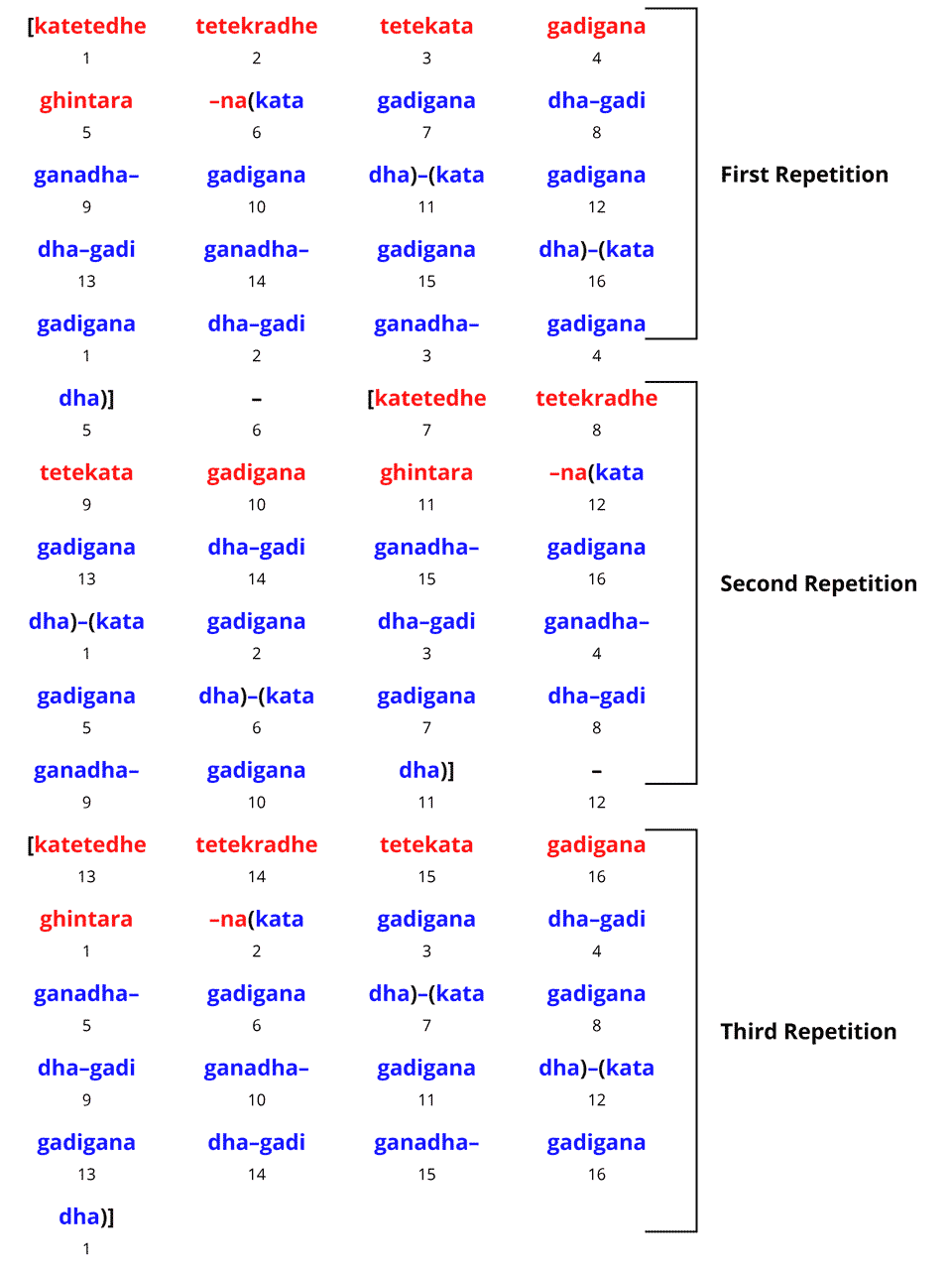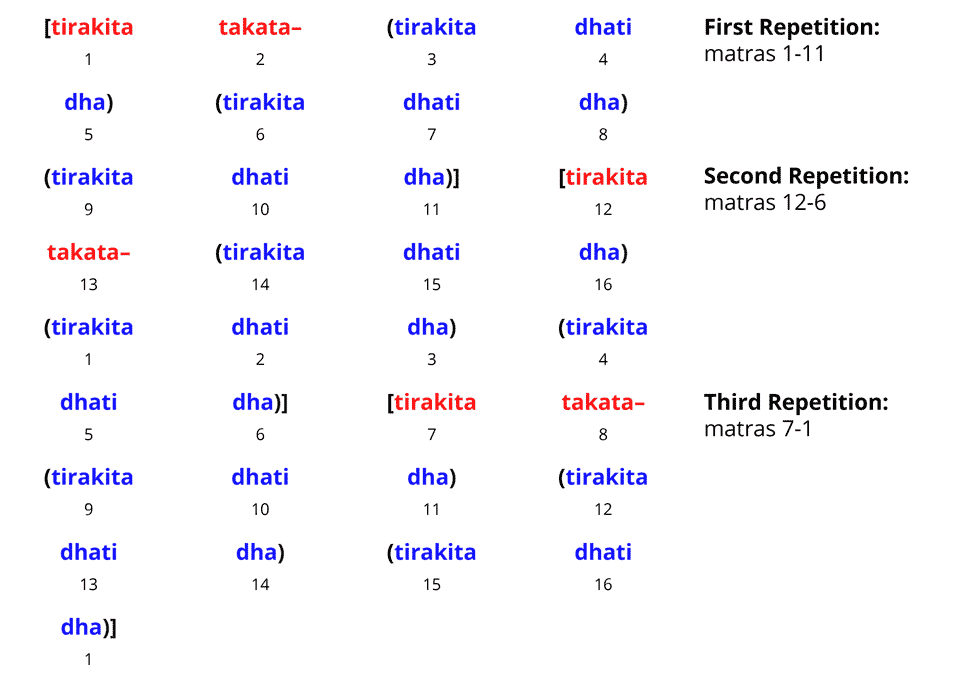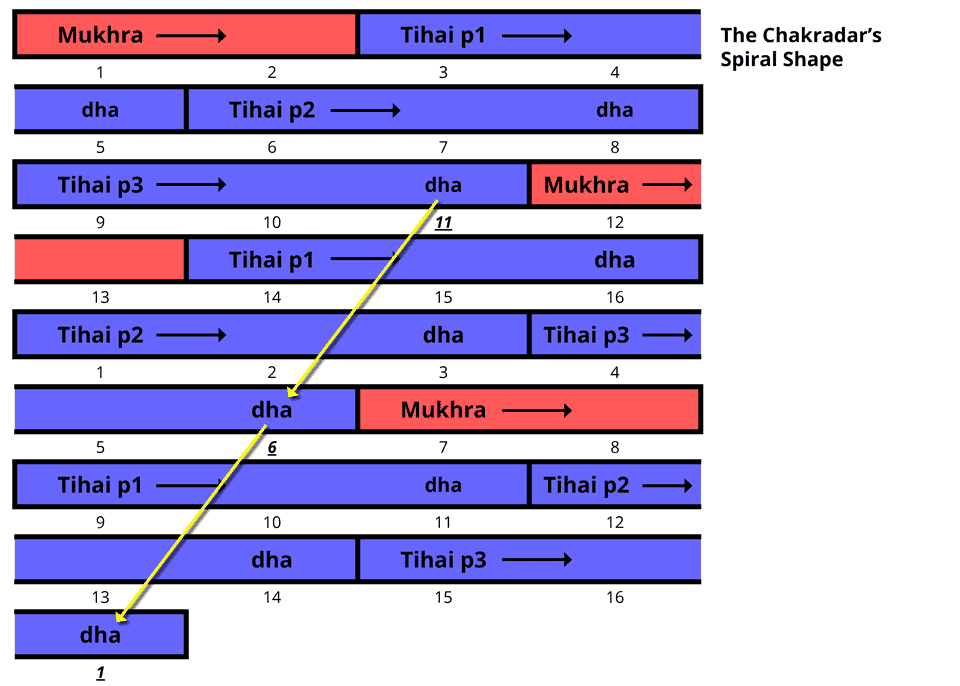Chakradār – चक्रदार
Quick Definition: A tukra-type composition, or a tihai, which repeats three times. There are both traditional chakradar tukras (most common in tabla solo), and chakradar tihais (played in both solo and accompaniment).
Literal Meaning: having rotation; having a spiral
Example Chakradar
Below is a traditional chakradar tukra in tintal (16-beat cycle). It has a tukra structure (opening + tihai) which is repeated 3 times. So each repetition has its own tihai (blue text).
Benares Chakradar Tukra Example:

Performed at medium speed:
Performed at faster speed, with theka:
(from Benares Chakradar Tukra 3)
Introduction to Chakradar
The chakradar is any tukra-type piece, or tihai, which is performed three times in a row. So if you understand how a tihai and a tukra are composed, you can understand the chakradar.
Traditional chakradar tukras will commonly use tukra-type phrases and patterns, such as the example above; while a chakradar tihai can be made from many different sources, including kayda, rela, bant, and mukhra. There are also other forms which have a chakradar structure, such as the uthan and paran, .
This gives us a wide range of chakradars, from very long, traditional chakradar tukras, to short improvised chakradar tihais.
Below, we’ll look at the basic characteristics of the chakradar form . And in the following sections, we’ll look at a variety of traditional chakradar forms in more detail.
The Basic Chakradar Form
The most common chakradar form has a tukra-type piece which is repeated three times.
"Tukra-type" means that the piece has the structure of mukhra (opening) plus tihai. This piece is then repeated three times:

Each of these three pieces is known as a pallā (पल्ला), though I will mostly use the term "repetition".
Example Chakradar
For an example, here is a simple repetition made from the phrase tirakita takata- (mukhra) plus the phrase tirakita dhati dha played 3 times (tihai):

To make a chakradar, we play this repetition three times so that the last dha falls on sam:

(from 4-Matra Mukhra 2)
Nauhakka-Type Chakradar
Most chakradars have the form above: mukhra plus tihai repeated 3 times. But some players feel that any tihai played three times is a chakradar tihai. This would include a nauhakka-type tihai (tihai with no mukhra played three times):

In the lineage of Chhotelal Misra, this form could be called either a chakradar tihai, or a nauhakkha.
The Spiral Shape of a Chakradar
The word chakradar is made from the term chakar (“rotation”, “spiral”, or “wheel”), and the suffix dar (“to possess” or “to have the quality of”).
In most chakradars, the last dha of each repetition does not fall on sam (the 1 of the tal) until the end. In this way, it is “spiraling” or “rotating” around the sam—or within the tal, some say—until the end.
You can see this spiral shape below in the form of the Simple Chakradar. This chakradar lasts for two avartans (cycles) of tintal (16-beat tal). Because the repetition is only 11 beats long, the final dha of each repetition is "spiraling" around in the tal until the end, falling on matras 11, 6, and 1:

The example chakradar above follows a similar pattern over 4 cycles of the tal, with the final dhas of each repetition landing on matras 5, 11, and 1. We’ll look at this form again in the section on the Simple Chakradar.
The Length of a Chakradar
Most traditional chakradar tukras are long. But other chakradars, such as chakradar tihais, may be short. The length will also depend on the lay (tempo) in which they are performed.
Common lengths include:
- 33 matras (2 avartans plus dha)
- 65 matras (4 avartans plus dha)
- 81 matras (5 avartans plus dha)
- 113 matras (7 avartans plus dha)
Traditional chakradar tukras will most always end on sam. They will also usually start on sam, but not always.
Chakradar tihais (from kaydas, relas, etc.) may be either long and short. They may start from anywhere, and usually end on sam.
The Phrases of a Chakradar
Traditional chakradar tukras will naturally use bols (phrases) commonly used in tukras.
Chakradar tihais, however, can be made from so many different kinds of compositions, that there is almost no limit to the bols that may be used.
References
Kippen, James. The Tabla of Lucknow – A Cultural Analysis of a Musical Tradition. Cambridge: Cambridge University Press, 1988.
Misra, Chhote Lal. Tal Prabandh. New Delhi: Kanishka Publishers, 2006. (Hindi)
—. Tabla Granth. New Delhi: Kanishka Publishers, 2006. (Hindi)
Naimpalli, Sadanand. Tabla for Advanced Students. Mumbai: Popular Prakashan, 2009.
Stewart, Rebecca Marie. The Tabla in Perspective. Unpublished Ph.D. thesis, University of California, Los Angeles, 1974.
Wegner, Gert-Matthias. Vintage Tabla Repertory – Drum Compositions of North Indian Classical Music. New Delhi: Munshiram Manoharlal Publishers, 2004.